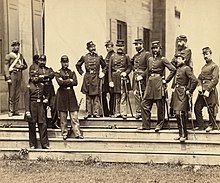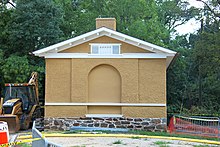Arlington House, The Robert E. Lee Memorial
Arlington House is a Greek Revival style mansion designed by the English architect George Hadfield.
His daughter, painter Mary Anna Randolph Custis married her childhood friend and distant cousin, then-U.S. Army Lieutenant Robert E. Lee, and all but one of their children were born there.
After the War, the property was returned to the Lee family, after a Supreme Court decision determined that the Federal Government had unlawfully refused payment, invalidating the subsequent confiscation.
[10] Pierre Charles L'Enfant was an engineer, architect and city planner who served in the Continental Army during the American Revolution.
The large center section and the portico, presenting an imposing front 140 ft (43 m) long, were finished 13 years later.
The property also included Arlington Spring, a picnic ground on the banks of the Potomac that Custis originally built for private use but later opened to the public, eventually operating it as a commercial enterprise.
Robert E. Lee, whose mother was a cousin of Mrs. Custis, frequently visited Arlington and knew Mary Anna as they grew up.
Two years after graduating from West Point, Lieutenant Lee married Mary Anna Custis at Arlington on June 30, 1831.
They spent much of their married life traveling between United States Army duty stations and Arlington, where six of their seven children were born.
To the west of Arlington House, tall grass and low native plants led down a slope into a natural area of close-growing trees the Custises called "the Grove.
"[12] About 60 feet (18 m) west of the flower garden, "the Grove" contained tall elm and oak trees which formed a canopy.
The estate needed much repair and reorganization, and Robert E. Lee, as executor of Custis's will, took a three-year leave of absence from the Army to begin the necessary agricultural and financial improvements.
[14] With Arlington House on high ground overlooking the capital, the federal government of the United States knew it needed to occupy the mansion or be left in an untenable military position.
[17][24] Meigs decided that a large number of burials should occur close to Arlington House to render it unlivable.
[19][27] Custis Lee was a major general in the Civil War and was captured by Union forces at the Battle of Sailor's Creek on April 6, 1865 (see David Dunnels White).
After several months of difficult negotiations, Lee and the federal government settled on a sale price of $150,000 ($4,905,000 in 2023 dollars).
[33] On March 4, 1925, the 68th United States Congress enacted Public Resolution 74, which authorized the restoration of the Lee Mansion in the Arlington National Cemetery, Virginia.
In 1955, the 84th United States Congress enacted Public Law 84–107, a joint resolution that designated the manor as the "Custis-Lee Mansion" as a permanent memorial to Robert E. Lee.
The National Park Service received jurisdiction over the building and some 28 acres (11 ha) of adjacent gardens (distinguished from the cemetery) beginning June 10, 1933.
[37] In 2020, members of Congress began to introduce bills to change the name again, to "The Arlington House National Historic Site".
[42] Within months of Union Army General Irvin McDowell occupying the home in 1861, Selina realized that several precious heirlooms were missing due to soldiers looting the property.
When she discovered that some of the Washington relics had also disappeared, she promptly provided a list of the missing objects to General McDowell and convinced him that the significance of the collection required his involvement.
He first secured the attic and basement areas to prevent further theft, then had the remaining Lee heirlooms shipped to the Patent Office in Washington, D.C., for safekeeping.
Four of Selina and Thornton's daughters provided crucial details about the house and its furnishings, and their input proved vital to the authenticity of the project.
[45] The property transfer, which involved 12 acres (4.9 ha) of NPS land, was intended to enable the Cemetery to increase its space for burials.
[46][47] Environmentalists expressed concerns that the agreement would result in the partial destruction of the 24 acres (9.7 ha) remnant of a historically important stand of native trees.
[55] From 2003 to 2007, the National Park Service conducted an archeological excavation of two outbuildings that once held Arlington House's slave quarters.
[60] Arlington House suffered significant damage in the 2011 Virginia earthquake, requiring the closure of the back halls and upper floor pending an architectural assessment.
National Park Service officials said they are likely to close Arlington House and the slave quarters for several months in 2016, during which most of the work will be done.











